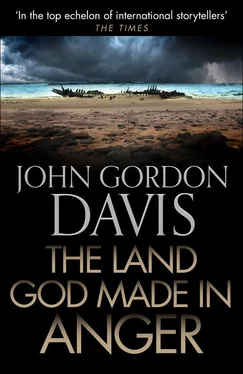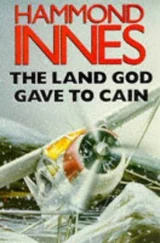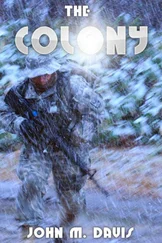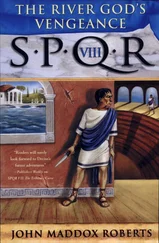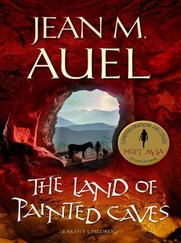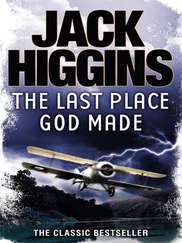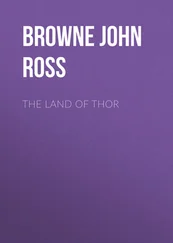McQuade stopped. From Jakob’s description he had expected the rocks to reach much further into the sea. ‘How can you tell?’
‘By the shape of that rock. Like a seal.’
‘So where did you first see the two men come out of the sea?’
Jakob pointed behind them.
McQuade turned the Landrover north again and drove along the sandy, hummocked shoreline. After about a mile Jakob signalled him to stop. Jakob got out, looked up the shoreline, at the pounding, seething surf, then down it. He studied the sea for a full minute, then began to trudge northwards, up the coast, with conviction.
McQuade followed him in the Landrover.
After ten minutes Jakob stopped, looked at the sea, then at the sky. He looked south, at the featureless surf. Then he looked east, inland, at the featureless sand dunes. He announced, ‘Here.’
McQuade looked at the moonscape of desert and sea.
‘How do you know? The coast has changed much in forty years.’
‘I know.’ Jakob pointed at the black Atlantic, the rows of breakers rolling in, the flatness beyond. ‘There,’ he said.
McQuade had to work fast. It was after five o’clock and the sun was dangerously low on the horizon: any angle approaching ten degrees had to be treated with suspicion. If he had to wait for tomorrow for the sun-sight he would have to wait until noon because the morning sun would be in the east, over the desert, and he would not have a usable horizon because of the dunes. He sat on the sand, hastily opened his notebook, put the sextant to his eye and pulled down some shades. He fiddled with the angle-adjuster, until he found the image of the sun. Then he slid the adjuster and brought the sun’s image down, until the lower limb of it just touched the horizon. He rocked the sextant, so the sun just skimmed the horizon in an arc. Then he looked quickly at his digital watch. He noted down the exact hour, minute and second, allowing for reaction time. Then he read off the angle shown on the adjuster, and sighed.
The angle of the sun was eleven degrees, twenty-four minutes and about thirty seconds. That was perilously close to ten degrees. If he had been at sea, where it did not much matter if he’d been a mile or two out, he would have used the angle: but in this case, if he was a mile out in calculating where on the earth’s surface he was sitting, he could waste a lot of money, and not find that submarine at all. The only sensible thing was to spend the night here and get a noon-shot tomorrow to verify his position.
Jakob had been watching him in amazement. McQuade picked up a piece of driftwood, and stuck it upright in the sand. He went to the Landrover and got out the provisions and the pots.
He poured brandy into two mugs, added a dash of water, and gave one to Jakob. He sat down.
If Jakob was telling the truth, somewhere just out there was an old German submarine. Loaded with loot. And James McQuade was going to be a rich man. He said to Jakob:
‘So somewhere near here lie the bones of the man who was killed? Do you think we will see his ghost tonight?’
Jakob stared at him.
‘Baas, we must not sleep here tonight! We must sleep a long way down the beach from this place!’
And McQuade knew that Jakob had been telling him the truth.
They slept two miles down the beach. McQuade was awake at sunrise, and thank God the sky was clear. He would get his sun-sights.
He built up the fire. Jakob was still asleep, curled up in his blankets; he had got drunk last night. McQuade put a pot of water on the fire. There was nothing to do but wait till noon. He went to the Landrover and got his fishing rod.
He walked along the beach, looking for bait. It was plentiful, in brown, spongy lumps the size of fists. He selected one and cut it open. The bait was inside little pockets – meaty, pink, like plums. He thought: H.M. could have survived on this stuff alone. He threaded a lump onto his hook. He swung the rod and cast out into the surf.
In fifteen minutes he had caught four good fish. He cleaned them and went back to the fire. Jakob was still asleep.
He made coffee. There was nothing to do but eat and wait.
At eleven-thirty they drove back to The Haunted Place. Five minutes before local noon McQuade sat down and faced north. He put the sextant to his eye, found the sun and adjusted the shades. He slid the adjuster and brought the sun down until the lower limb of it just skimmed the horizon. He looked at the angle, then at the time, but did not make any notes.
Jakob was watching him in amazement. McQuade smiled at him. He waited half a minute, then raised the sextant again, found the sun, tweaked the angle-adjuster, and skimmed the sun on the horizon again. The angle was a minute of arc higher than last time. He waited half a minute, and did it again. At noon the sun stays at its zenith for about four minutes before it begins to descend into afternoon. About five minutes later, after measuring half a dozen times the angle between the sun, his eye, and the horizon, he was satisfied about the zenith.
He noted down that angle. He allowed seven feet for Dip, and allowed for the sextant’s Index Error. He then subtracted the sun’s noon angle, in degrees and minutes and seconds, from ninety degrees, zero minutes, zero seconds. The final result was an exact parallel of latitude.
This piece of beach he was sitting on was exactly nineteen degrees, seventeen minutes, forty-eight seconds South. Assuming Jakob was right, somewhere out there, due west along that latitude, lay the submarine. Probably about half a mile out.
With the next part of the navigational calculation he could take his time. He had a coffee. He gave the sun an hour, then took another sight with the sextant. He noted the exact time.
He used the Landrover’s flat bonnet as a table, and began his calculations. He unfolded his nautical chart of the Skeleton Coast and drew in his latitude. He read off the longitude of the point where his latitude line crossed the coast. That in itself was enough to tell him exactly where on the earth’s surface he was. But, to double-check, he wanted to put in the afternoon position line as well. He calculated his Local Hour Angle, noted down his post-noon sun angle, allowed for Dip and Index Error, opened the nautical almanac to the page for that day, found the hour, did the calculations and arrived at Height Observed. He then opened the sight-reduction tables to the appropriate page, and worked out Height Calculated. He subtracted that from Height Observed and came up with a minuscule Intercept. He then drew in the position line on the chart. It intercepted at the point where his latitude line crossed the coast. He was quite satisfied about where on the earth’s surface he was standing.
He took a deep breath. Okay, the first step was to verify the submarine’s existence. Bring the Bonanza up here and sweep the ocean floor in a pattern. Her depth-sounder would show up anything as big as a submarine lying on the ocean bed.
Then dive down and have a look at it.
How do you get into a sunken submarine?
He had no idea. Worry about that later.
What were the legal ramifications? And if word got out there’d be fortune-hunters from all over the world looking for this submarine. So, consult a good maritime lawyer, and meanwhile tell absolutely nobody. He’d have to tell the Kid, Tucker, Elsie and Potgieter of course, but he’d give the Coloureds a few days leave and bring the Bonanza up here with a skeleton crew.
It was a long shot, but it was worth looking into: had H.M. survived the Skeleton Coast? Was he alive today? He might well have survived: he was a youngish man in 1945 and he had had Jakob’s water bottles, which he could have replenished at the Ugab river by digging. He had a gun and he might have shot a buck at the Ugab. Or a seal. If he reached Swakopmund, he would have gone immediately to a dentist because he would have been in pain. And probably seen a doctor, to treat his gashed arm. Records of all this might still exist. If McQuade could uncover those records he might find out H.M.’s name.
Читать дальше
